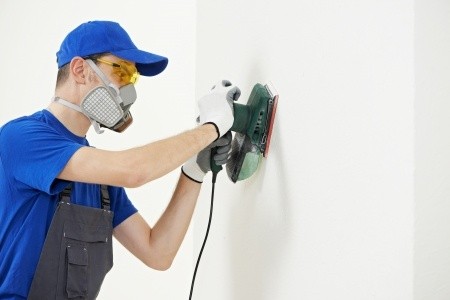
You need protective equipment to remove lead paint safely
Read on to learn the risks of lead exposure, and how you can remove lead paint safely if you believe you have it in your home.
We can safely remove your lead paint
The dangers of exposure to lead
Those most at risk from exposure to lead are children under the age of six, and pregnant women and their developing foetuses. However, lead poisoning can still lead to brain damage and death even in healthy adults.
Children exposed to even low levels of lead are at risk of associated developmental problems, low IQ, stunted growth, anaemia and hearing problems. For a developing foetus it can mean intrauterine growth restriction and premature labour, meanwhile the expectant mother can herself become extremely unwell.
In anybody, lead exposure can cause cardiovascular problems, kidney problems and reproductive problems.
Testing for lead based paint
The best way to test for traces of lead based paint is by using 5% sodium sulphide solution. This is most commonly sold in paint shops and some pharmacies. To perform the test, you will need to cut into and expose the deepest layer of paint and apply a drop of the sodium sulphide. If the solution turns a brown or black colour, it means that lead is present.
If you do not want to carry out the test yourself, you can alternatively get in touch with a health protection officer at your local public health unit, who should be able to carry out the test free of charge.
What to do if your home tests positive for lead based paint
If you discover lead based paint is present in your home, you have two options:
- If the paint is in good condition – that is it has not visibly deteriorated and is not flaking away at all – it may be appropriate to apply an overcoat of a non-hazardous surface coating. This is not a permanent solution to the problem, but would be safer than an improperly carried out removal job. This is not a safe solution in areas where the paint is liable to be chewed or damaged, eg. by a child or pet.
- If the lead based paint is showing any signs of deterioration at all, it is essential that the paintwork is safely removed in full, to prevent any risk of the dust or flakes from being ingested by humans or animals. This is the only way to completely eliminate the hazards of having lead based paint in your home, even if it is currently in good condition.
The steps to removing lead paint safely
The removal of lead based paint in itself is a risky process, both for the person removing it and for anybody else in the vicinity. The primary way lead enters the body is through inhalation of the dust and fumes from lead paint, so an improperly carried out removal job can be extremely dangerous.
The most reliable way to safeguard yourself and your family against the risks associated with this job is to hire the services of a professional who specialises in the safe removal of lead based paint, such as those offered by Northland Painters. Let us do all of the hard work for you. However, if you wish to carry out the task yourself, make sure you take the following precautions:
1. Protect yourself
The main risk in the removal of lead based paint is in the potential to ingest lead-contaminated dust. It is therefore essential to perform the task whilst wearing a high quality, correctly fitted toxic dust respirator. If you are using the disposable type, this must have a double headstrap. Check the respirator you are using meets the New Zealand/Australian Standard NZS/AS 1716:2012 (Respiratory Protective Devices).
The accumulation of dust on your clothes and especially in your hair poses another threat to safety. It is highly recommended that you carry out the task wearing protective overalls and a hat or something else to cover your hair. Change out of contaminated clothing as soon as you have finished or take a break, and always wash contaminated clothes separately to the rest of your washing.
Do not smoke or eat whilst carrying out the job as you may transfer particles of contaminated dust into your mouth. Make sure you carefully wash and dry your hands and face before eating, smoking or coming into contact with children.
2. Prepare your surroundings
Firstly make sure that anybody who is not essential to the removal process has vacated the premises in order to eliminate the risk to others. This is especially applicable to children and animals.
If the paint removal work is inside your house, remove all curtains and furniture from the room and completely cover the carpets and any other fixtures and fittings with drop sheets. If you are burning the paint off the walls, remember to ensure that these sheets are fireproof. Disposable polythene sheets are recommended rather than reusable dust sheets, as the risk presented by improperly cleaned reusable sheets is too high.
It is essential to ensure that the sheets form a completely tight fit around all edges, corners and surfaces in the room to avoid any risk of contaminating your house. Far greater care should be applied to this precaution than you would exercise in a typical home decoration task.
If you are removing paint from outside your house, ensure all doors and windows to the property are securely closed to avoid any risk of contaminating indoors. If you have neighbouring houses nearby, inform them of the work you are carrying out and advise them to take similar precautions. Avoid carrying out the task in windy weather, to prevent contaminated dust from being spread. Similarly, if carrying out the work indoors, ensure there are no draughts in the vicinity that may spread the toxic residue.
All debris should be collected on a large groundsheet which can be wrapped up and packaged away at the end of the job. If working on scaffolding you should attach a groundsheet underneath to catch the paint debris.
3. The methods of removing lead paint
There are various methods of lead paint removal, all with varying degrees of safety and work required. The safest method of removal, and the one most advisable for DIY lead paint removers, is by wet sanding the area in full. This involves spraying the affected surfaces with water and slowly removing all traces of paint using either wet and dry sandpaper, or sharp scrapers. This techniques creates the lowest levels of toxic dust residue, but it is among the most labour intensive methods of carrying out the job.
Other methods include power sanding, which produces great quantities of lead contaminated dust unless the device is fitted with a dust collection system or a high efficiency filter and is carried out by somebody who is skilled in using the tool, or burning away the paint with the use of an open flame, however this method releases toxic lead fumes and poses a serious hazard to the remover. Neither method is particularly advisable in a DIY scenario.
Small surfaces may be able to be treated with the use of certain chemicals to remove the lead paint if appropriate safety measures are taken, such as the wearing of safety goggles and gloves and strict adherence to packaging instructions.
If the work you are carrying out is outdoors, you can water blast the affected area to remove the paint in a less labour intensive manner than wet sanding, as long as a thorough cleanup operation is carried out, and measures are taken to prevent the spread of contaminated flakes or dust to yours and neighbouring properties.
4. The clean-up operation
When you have finished, you will need to completely remove the contaminated dust from the surrounding environment. Using a high grade commercial vacuum cleaner fitted with a high efficiency dust filter, vacuum the entire area around the groundsheet. Next, wet wipe all surrounding surfaces, and vacuum to remove any further traces. You will need to safely dispose of the contents of the vacuum cleaner immediately.
Ensure all paint debris is securely disposed of in appropriate closed containers, such as sturdy plastic bags. Small amounts of debris can be disposed of in the household refuse collection or at the local rubbish tip. If you are unsure, contact your local authority about approved disposal sites. Never burn the debris from lead paint removal.
What to do if you think you have been exposed to lead paint
Even exposure to low levels of lead can be very dangerous. Symptoms of lead poisoning might start with reduced appetite, fatigue, loss of sleep, constipation and stomach ache. Sometimes there may be no symptoms at all. But if left untreated, lead poisoning can be fatal.
Some people find that the first member of their household to begin showing signs of exposure to lead is one of their pets. If this is the case for you, it is important to get everybody else checked out too.
If you are worried that you or your children may have been exposed to lead paint, seek medical attention and request a blood test to check your lead levels.


